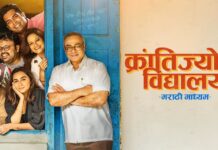INFORMATION MEETS
“I constantly ask my members kyon Bambai marne aate ho. Let the producer come to you to sell his film.”
– SANTOSH SINGH JAIN
RAJ VAIDYA
Kind, controversial, autocratic, ever-smiling, shrewd… These are only a few of the adjectives that people normally use to describe Santosh Singh Jain, the longest-serving president of the Central Circuit Cine Association. One of the most senior members of the film industry, Jain continues to remain actively involved with film trade and its problems. He has just completed his 33rd term as the CCCA president at an advanced age of 70. But the speed with which he finishes work on hand could give a 17-year-old a veritable complex. In these 33 years, he has led the CCCA with great acumen, vision and pragmatism, which has made the CCCA undoubtedly the strongest body of the film trade in India today. This is what late H.S. Subba Rao, the founder-member of the largest film Association and the one who was responsible for bringing Jain into Association politics way back in 1958, had to say of his ward in 1997, “I am proud of the achievements of CCCA under your able leadership…. All this glory of CCCA needs to be attributed to a dynamic personality like you and that a person whom I know, does not walk, but runs; has a mind that of a computer and with the agility, plans like a programmer and works like a robot; but to all his technical excellence, has a heart of gold that beats and oozes out compassion, concern and humility.” Little wonder then that Jain Sahab is affectionately and, of course, appropriately, referred to as “Daddy” by members of his large family, the CCCA.
For us at Information, Jain Sahab has always been a family member. Sure, your late editor, Shri Ramraj Nahta, in his capacity as the president of the IMPPA, sometimes did have professional differences with Jain Sahab, but to his credit and Ramraj-ji’s, that could never affect the bond of affection that they and the entire Information family shared. We met Jain Sahab this week to talk about the CCCA of which the annual elections are around the corner. Young as ever, alert to what’s going on in the world of films and busier than the proverbial bee (he had visitors like Naraindas Mukhija, Laxinarayan Kapoor and Dayanand Kapoor call on him even while the interview was on), the man shared his views with us on a variety of issues. Excerpts from our conversation:
Taking a trip down memory lane, can you tell us how you entered Association politics?
The Central Circuit Cine Association was founded way back in 1952. Late H.S. Subba Rao was its founder-president. Around that time, I was in service with the Golchas. When I had completed three years in their service, my bosses permitted me to enter Association politics. Consequently, I contested in the following CCCA elections and was elected at the very first attempt. Before being elected, I used to often criticise the fact that bade logon ne CCCA mein apni jamaat bana li hai. Thus, when I was elected the first time, late Subba Rao told me, “Now that you have become part of the Association, learn why this is so!” Further, he suggested that I file my nomination for the post of the general secretary. He even went to the extent of threatening me that he would not become the president till I agreed to become the general secretary. Thus, in my very first year in the CCCA, I became its general secretary.
For a few years, I continued working in that capacity. Eventually, I became the president of the CCCA for the first time in 1964.
….We have heard that you were offered a paid presidentship because of the fact that the then CCCA president, late Swaroopchand Jain, was too busy with his own work….
…..That is not true at all. The truth is that I became the president only after Swaroopchand-ji had retired.
You have been at the helm of the strongest body of distributors and exhibitors in India for an astonishing 33 years. What qualities of yours have stood you in good stead through this long innings?
I don’t know about the qualities, but I can only say this — I try to serve people to the best of my abilities. May be, people respect me for that. I have always made myself easily approachable for anyone who needs my help. Fortunately, I have been able to build up a large number of cordial relationships with people in all sectors of the trade. So, may be, it is the fact that people like me because I am widely accepted in the trade.
Here, I would also like to mention the contribution of my children. Both my sons have taken over my business ably. While one lives in Jaipur, the other is in Indore. They are handling the family business so well that I have become absolutely free to pursue work related to the Association. As a result, I can afford to devote all 24 hours to this work and attend to everyone who approaches me for help.
Being the veteran president of a distributors’ body, how would you describe the change in the producer-distributor relationship over the years?
In the initial stages of Indian cinema, there used to exist an ‘agency system’ between the producer and the distributor. Big studios like Ranjit, for example, would have their appointed agents who would release their films. In those times, there used to be no written agreements, MG royalties, etc. Everything worked on an agency basis. This went on for quite some time. Later, came the trend of ‘freelancing’. Earlier, most people in film production were Gujaratis. But, it was only after a few Punjabi people entered into the field some time after Independence, that the nature of film sales began to be commercialised. These new entrants began selling their films to anyone who paid them more money. This is how the ‘freelancing system’ came into being. Minimum guarantees became a natural outcome of this system. And once the minimum guarantees came in, the thumb-rule was set that films were sold to those who paid the highest amount. This continues till date. An unfortunate outcome of this system was that it sounded the death-knell for that permanent link that existed between the producer and his agent (the distributor).
Once, film prices were inclusive of print costs. But when the excise levy came into effect, it became difficult to calculate print costs as the levy would vary from time to time. So, people began excluding the cost of prints from the price of films. Even this continues till date.
And what is the scenario today?
Producers have become extremely commercial-minded. Today, they want maximum profits. Films are still being made, as they were earlier, but now, people sell off their films entirely and free themselves of its outcome at the box-office. Earlier (in the agency system), if a film flopped, its distributor would not lose anything. The loss would be borne by the banner which was usually big enough to sustain itself in spite of the losses. There were several big and prestigious banners like B.R. Chopra Sahab’s or Mehboob Sahab’s in those times, as opposed to none at all today.
I constantly ask my members kyon Bambai marne aate ho. Let the producer come to you to sell his film. After all, whenever I talk to a producer, his permanent refrain is that the distributor went to him (the producer) to buy the film and that he (producer) did not go to the distributor to sell it. I try to educate my members that, ideally, the producer must go to the distributor and not the other way around. We have a saying which means that when you go to a kumbhar (a potter) to buy a ghada (a pot), the price is different from the one he quotes when he goes into town to sell his wares. The price is always higher in the former case. Till the time a stage is not reached where the producer-distributor scenario is reversed, there is just no way film prices will come down. Either the distributors wake up to the fact now, ya to phir, woh mar-mar ke seekhenge!
What would you rate as your biggest achievements as the president of the CCCA?
Today, when you call the CCCA the strongest body of distributors, you say that because we are disciplined. Attaining this level of discipline among our members has, perhaps, been my biggest achievement. Today, our self-regulation makes it imperative for our members to deal within the Association alone. No one can do any business in our region without becoming a member of the CCCA.
Secondly, we have been able to formulate our own judiciary. Whenever our members get into a dispute with anyone, we settle it among ourselves — like in a family — without any external interference. To this date, we do not allow our members to go to court. The fact that no one has so far felt the need to do so, speaks volumes for the efficiency of our judiciary. That should be counted as yet another of my achievements.
Then, there is also the way the CCCA has grown over the years. The C.P.C.I. Rajasthan circuit itself is so big that it is impossible to handle all its work from one place. Therefore, we have divided our operations into four separate branches — Amravati, Bhusawal, Indore and Jaipur. What is more, we have made each of the branch autonomous. The outcome is that the management of the Association has become significantly easy. Having branches also helps our members to a very huge extent as they can get their work done with their respective local branch. Moreover, each of our branches now has its own infrastructure for its operation. Today, we have Association buildings in all the four places. In fact, by the end of the year, our new building in Indore will fetch the CCCA several lakhs per year by way of rent, thereby eliminating all future worries as far as the operational expenses go. Just as a father strives to make his children self-sustained, I have made all the four branches of my Association self-sustained.
Quite a remarkable record! But is there anything — any step you took — that did not yield a favourable result?
You could say that the ceiling that we proposed on the maximum assignments of a star at a given time was a disappointment. It was way back in 1966, when we proposed that a star should not do more than six films at a time. Later, in the late ‘eighties, when we revived the ceiling (12 films at a time), we soon began to find out that a few greedy producers were trying to circumvent the ceiling by signing the defaulting stars and then, offering their films at half their original prices to our members. A number of our members grabbed at such tactics. Eventually, we pulled back the ceiling as a compromise to save the Association from breaking. On hind sight, one feels satisfied that the move, even though unsuccessful, brought about a great deal of awareness in the industry and today, no star has more than 12 films in his/her hands even though there is no ceiling.
Another similar failure came when we proposed a ceiling on film prices in our region years ago. We had set the maximum price for C.I. at Rs. 7.5 lakh. But again, a few greedy producers introduced the ‘advance and MG systems’ while some distributors started paying money ‘under the table’. Eventually, the price ceiling was withdrawn.
From this year, the CCCA committee’s tenure will be for two years instead of one, as has been the practice so far. What is the rationale behind this?
This is done only to help a new member of the executive committee settle in the Association in a better way. Over the years, we have found that one year is too short a period for a freshly elected member to grasp and contribute to the working of the CCCA. Hence we have gone in for a longer term.
It is often said about you that you are not averse to even bending the rules sometimes to achieve an end for the Association or to teach someone a lesson. How do you react to this?
(Laughs) I cannot recollect any such incidents. (After a bit of prodding) Well… there was one incident when a particular distributor wanted to become a member of the CCCA. But I was aware that the man had dues outstanding in his name in Bihar where, too, he had a distribution office. I was aware of it because the settlement between the aggrieved party and this aspiring CCCA member was done by me in my own office. I recall that the settlement was fixed at Rs. 7 lakh, which the distributor ultimately paid after harassing the aggrieved party a great deal. With this background knowledge I had of the distributor, when he approached the CCCA for membership, we refused. He went to the MRTP but the dispute between us is still not finally settled. To become our member through the MRTP order, he had to deposit Rs. 5 lakh with the MRTP. I only told the MRTP Commission this, “How can you compel me to take in a person who I know for a fact is of a bad character? You say that our rules are so strong that if he performed an illegal deal, we would surely be able to catch him. Even as that may be true, how can you expect me to let a thief enter my house, wait for him to commit a theft and then take action against him?”
What are the problems facing the trade in C.P.C.I. Rajasthan today?
Cable piracy continues to remain a major problem in our region as in many regions all over the country. Today, cable networks show a film within a day of its theatrical release. If caught, the cable operator comes up with the handy excuse that it isn’t him but some other person who is illegally tapping his cable lines and broadcasting the film! This is just not done. I mean, if tomorrow someone comes and puts an illicit object in my house, can I use an excuse that even though it is my house, I have not committed any crime since I have not put the object there? How then can the cable operators be allowed to get away with such a ridiculous excuse? I am already in the process of writing to the central government to introduce changes in the law so that the cable operators can be prevented from using this silly excuse. But, I really think, it is the whole industry which needs to unite and fight the menace together.
Another problem that we are facing is that there is a negative growth in the number of cinema halls in the region. Every year, we face a consistent decline in the number of cinemas from the previous year. We are urging the state governments to introduce incentives to encourage building of more cinemas. We also need better cinema halls in the region. Today, we have a large number of halls which have obsolete facilities. Now that technology has changed and new sound systems have come in, the average cinegoer is put off by the cinema halls which do not give him these new facilities.
The entertainment tax scenario is also not helpful either. Some time ago, we managed to get the government to bring it down to 50% in Rajasthan. But as soon as the state government changed there, it was reverted to 100%. In Madhya Pradesh, however, we have managed to get it down to 75% from the earlier 150%. But, I would really be happy if entertainment tax was scrapped altogether. I foresee a time in the near future when it will no longer be relevant. Already, it has become so in the light of so many new media that provide entertainment for free.
What is the secret behind you being so active even at the ripe age of 70?
I am a regular morning walker. Every day, I am out of the house at 5.30 a.m. for a walk. I lead a healthy life and have a fulfilling family life as well. I have several grandchildren and great-grandchildren as well, who together with my children and their spouses, fill me with enormous vitality for life day after day.
You are often fondly addressed as a ‘lovable Hitler’…..
(Laughs loudly) You are right. A lot of people call me that. Actually, the epithet was given to me by Chopra Sahab (B.R. Chopra) because of a couple of incidents. In my early days in the trade, I was working with the Golchas, as I mentioned earlier. I was managing Maratha Mandir cinema which had very newly opened with Chopra Sahab’s Sadhana. Chopra Sahab himself used to visit our cinema quite often. Since the cinema was new, we used to keep 10-20 tickets aside in every show to accommodate late entrants and others who, for some reason, couldn’t get tickets. It so happened one evening that a family of six landed at the cinema just before the evening show. They pleaded for tickets, saying that they had the tickets for the previous show, but had mistakenly thought that they were for the evening one. They had travelled quite a distance to see the movie, they added. I immediately ordered the booking clerk to issue them the tickets and told him not to take any money from them. My boss, who was also present there alongwith Chopra Sahab, asked me how I could give the tickets away for free. I explained, “Humein cinema ki izzat banani hai, iss ki chhaap banani hai. Logon ko hamare cinema ke baare mein baat karni chahiye. Fine. These people did make a mistake, but they shouldn’t feel disappointed that they came to Maratha Mandir and couldn’t see the film.” Chopra Sahab, who had been silently watching the whole thing so far, walked up to me and told me that I had done a very smart thing.
Around the same time, we were facing another problem at Maratha Mandir — that of goondaism. The area in which Maratha Mandir is situated used to be a very downmarket area called Madanpura then. One of the biggest problems we faced were from the black marketeers and eve-teasers. Soon, I began to personally catch the miscreants by their collars and clobber them. A few days later, one of the gang leaders in the area approached me and asked me to stop beating up his men. I calmly told him that as long as they would sell my cinema’s tickets in black and tease our lady patrons, they would continue to receive the same treatment from me. The gang leader was a little taken aback at my bold reply. He asked me what I could do if his men were to engage in the same activities outside the Maratha Mandir compound. I said to him, you can do what you want outside the compound. But I dare you not to enter the compound with your bag of foul tricks. The gang leader went away without a word. The menace, needless to add, was curbed then and there.
Then I recall this incident when at the time of release of one of Chopra Sahab’s films, war had broken out. Chopra Sahab called me up and explained that if his film was released in such a scenario, he would have to bear untold losses. I asked him to keep his cool and called up Laxminarayan Kapoor of Bharti Films, Indore, who was one of Chopra Sahab’s distributors who had already taken the delivery. I told Kapoor, “Don’t release the film even though you have taken delivery of prints. Keep the prints at home till the war is over. If you want your money back, I’ll talk to Chopra Sahab and get it back for you.” Kapoor heeded my request and when I conveyed the good news to Chopra Sahab, he thanked me profusely and began calling me a ‘lovable Hitler’ from that day onwards. The name has stuck since then……
LATEST POSITION
HELLO BROTHER reaped the benefit of the holidays last week (elections, Ganesh Chaturthi) and managed to collect very well despite poor reports. Its collections nose-dived from 5th day onwards.
Hello Brother 1st week Bombay 63,33,337 (84.65%) from 12 cinemas (7 on F.H.); Ahmedabad 6,85,455 from 3 cinemas, Padra 1,51,007, Adipur 1,49,391; Pune 17,02,513 from 5 cinemas, Kolhapur 2,37,501, Solapur 3,64,653 from 3 cinemas (1 in matinee); Delhi 64,85,886 (80.25%) from 13 cinemas (2 on F.H.); Lucknow 5,05,389 (100%), Bareilly (6 days) 1,97,924, Hardwar 1,05,000 (43.15%); Calcutta 22,72,737 from 15 cinemas (1 in noon); Nagpur 9,07,689 from 4 cinemas, Jabalpur (6 days) 2,24,912, Amravati (6 days) 1,87,798, Akola 1,91,567, Raipur (6 days) 1,72,372, Jalgaon (6 days) 2,31,709, Wardha 98,025, Chandrapur 1,88,748; Bhopal 1,62,181; Jaipur 12,89,805 from 4 cinemas, very good, Bikaner 1,93,284; Hyderabad (gross) 34,20,351 from 12 cinemas (7 on F.H.), Aurangabad (gross) 2,15,000 (1 unrecd.).
1947 Earth also got the advantage of the holidays and has, therefore, done well in major cities. 1st week Bombay 34,98,839 (74.82%) from 9 cinemas (5 on F.H.); Ahmedabad 2,50,000 from 2 cinemas, Baroda (matinee) 21,143; Pune 6,49,846 from 3 cinemas, Solapur 88,114 from 2 cinemas (1 in matinee); Delhi 14,64,175 (80.59%) from 3 cinemas; Lucknow 2,19,434, Bareilly 36,476; Calcutta 8,55,395 from 9 cinemas; Akola 80,370; Indore 1,81,350 from 2 cinemas (1 on F.H.), Bhopal 94,664 (1 unrecd.); Jaipur 2,84,786 from 2 cinemas; Hyderabad (gross) 14,17,592 from 8 cinemas (1 in noon), share above 7 lakh.
Shaitanon Ka Honeymoon (dubbed) 1st week Bombay 1,50,432 (29.90%) from 2 cinemas (1 on F.H.); Pune 60,413.
Sangharsh 2nd week Bombay 12,02,897 (54.21%) from 6 cinemas (6 on F.H.); Ahmedabad 2,63,839 from 5 cinemas (1 unrecd.), Baroda 50,042, Rajkot (matinee) 13,850; Pune 4,27,196 from 3 cinemas (1 in matinee), Solapur 97,308; Delhi 7,01,845 from 3 cinemas (3 on F.H.); Lucknow 2,22,303, Bareilly 43,413, Hardwar 20,000; Calcutta 3,99,425 from 3 cinemas; Nagpur 1,11,272, Jabalpur 39,563, total 1,39,819, Amravati 1,08,907, Akola 59,815, Raipur (gross) 77,279, 1st Jalgaon (5 days) 1,37,901; 2nd week Indore 1,52,000 from 2 cinemas, Bhopal 89,763 from 2 cinemas; Jaipur 1,49,269, Ajmer 51,488, Bikaner 33,295; Hyderabad (gross) 3,07,080.
Godmother 2nd week Bombay 8,00,518 (62.23%) from 3 cinemas; Ahmedabad 3,46,818 from 2 cinemas (1 unrecd.), Baroda 60,073, Rajkot 98,940, Jamnagar 55,006 from 2 cinemas (1 in matinee); Pune 1,31,435 from 2 cinemas; Delhi 3,39,297; Calcutta 1,27,686; Hyderabad (gross) 1,19,531 from 2 cinemas (1 in noon & 1 in night shows).
Baadshah 3rd week Bombay 28,97,431 (70%) from 8 cinemas (6 on F.H.); Ahmedabad 4,47,623 from 5 cinemas (1 unrecd.), Rajkot (7 shows) 30,100 (1 in matinee unrecd.), Jamnagar 64,576 from 2 cinemas (1 in matinee), 1st week Bhuj 61,000; 3rd week Pune 7,86,219 from 5 cinemas (1 in matinee), Solapur 1,19,228 from 2 cinemas (1 in matinee); Delhi 14,24,398 from 7 cinemas (1 on F.H.); Lucknow 3,93,107, Bareilly 60,038, Hardwar 29,669, total 2,03,825; Calcutta 2,77,707; 1st week Puri 58,396; 3rd Nagpur 1,90,274 from 2 cinemas, Jabalpur 1,15,314, total 5,88,205, Amravati 91,687, Akola 68,548, Raipur (gross) 1,44,806, Chandrapur 46,155, total 2,99,000; Bhopal 1,03,748; Jaipur 2,67,303, Bikaner 82,600; Hyderabad (gross) 3,63,596; Vijayawada 3 weeks’ total (gross) 7,50,498.
Taal 5th week Bombay 23,12,126 (71.02%) from 6 cinemas (8 on F.H.); Ahmedabad 3,38,416 from 4 cinemas, Baroda 1,85,646, Jamnagar 59,486; Pune 4,36,892 from 3 cinemas (1 in matinee), Solapur (7 shows) 60,668; Delhi 18,14,614 from 6 cinemas; Lucknow 2,78,114; Calcutta 3,98,711 from 2 cinemas; Nagpur 1,04,122, Jabalpur 57,485, total 5,72,393, Amravati 1,21,229, Akola 78,593, Raipur (gross) 1,17,554, total 11,99,526, Jalgaon 76,450 (4th 1,15,000), 3rd week Wardha 35,156, 5th Chandrapur 58,177, total 5,68,631; Indore 1,11,000 (1 on F.H.), Bhopal 94,653; Jaipur 6,95,670 from 2 cinemas, Jodhpur 1,20,000, Ajmer 63,918; Hyderabad (gross) 7,79,784 from 3 cinemas (1 in noon), 5 weeks’ total in Aurangabad (gross) 13,54,560; 5 weeks’ total (gross) in Vijayawada 18,24,059, in Visakhapatnam 10,11,697, in Anantapur 6,31,241, in Kurnool 5,36,353, in Cuddapah 2,66,788, 3 weeks’ total in Rajahmundry (gross) 3,50,338.
HASRAT JAIPURI DEAD
Veteran lyricist Hasrat Jaipuri passed away on the evening of September 17 at Holy Family Hospital at Bandra, Bombay, due to kidney failure. The lyricist had, three days back, fallen down at his home and hurt his head. He developed complications resulting in kidney failure. He was 76 and is survived by his wife, two sons and a daughter.
Hasrat Jaipuri, who began his career as a lyricist with Raj Kapoor’s Barsaat in 1947 along with Shailendra, was more of a romantic poet, employing simple words and idioms in his lyrics. But he had a penchant for including sweet-sounding Urdu expressions in his songs — like ‘chashme buddoor’ in the song Teri pyar pyari soorat ko, ‘uff-yu-maa’ in Ye ankhen uff-yu-maa and ‘shabba khair’ in O shabba khair.
Hasrat wrote a number of hit songs tuned by Shanker Jaikishen. He also occasionally worked with other music directors like S.D. Burman (Tere Ghar Ke Saamne and Ziddi), C. Ramchandra (Anarkali) and Vasant Desai (Jhanak Jhanak Payal Baje).
He dominated the music scene for more than four decades. From his first song, Bichhde hue pardesi (Barsaat) to Sun sahiba sun (Ram Teri Ganga Maili) and more, he wrote over 250 songs. At the time of his death, he was working on a collection of poems which he had completed recently.
Hasrat Jaipuri, the last of the survivors of the charmed music circle of Raj Kapoor — comprising, besides him, Shanker Jaikishen, Shailendra and Mukesh — has finally bid adieu. When he was bereaved by others of this charmed circle, Hasrat lived his remaining days in the spirit of his own song, Gham uthaane ke liye main to jiye jaaoonga from Mere Huzoor.
SULOCHANA CHATTERJEE PASSES AWAY
Veteran actress Sulochana Chatterjee passed away on 30th August in Bombay due to cardiac arrest. She was 71.
Born on 9th October, 1928, Sulochana Chatterjee started her film career as a singer but turned a heroine in 1944. She was a natural performer and a popular heroine of family dramas like Badi Bahu, Bahurani, Bajuband, Veena, Geet Govind, Lathi, Jeevan Saathi, Maa Ka Pyar, Apni Chhaya, Lakhpati, Shagun and Grihasthi, a super-hit of 1948, directed by S.M. Yusuf. Later, she played mother’s roles and other character roles. Some of her memorable films as character artiste are Jagte Raho, Khandaan, Pooja Ke Phool, Piya Ka Ghar and Saraswatichandra.
Sulochana Chatterjee led a simple and dignified life. She also worked in Bengali films. Baba Taraknath, produced in Bengali by her husband, Bhanu Bannerjee, was a super-duper hit.
MIX MASALA
YOUNGEST
Bhushan Kumar, the young boss of Super Cassettes, will contest the elections to the IMPPA this year. At just 21 years of age, it makes him the youngest ever contestant for the executive committee of the oldest association of producers.
3-E
Education-Entertainment-Enlightenment
One Cinema — 164 Queries!
How many questions can you ask a cinema-owner/exhibitor/cinema controller regarding his cinema? At the most, a dozen? Or 50? But the Rajshris have prepared a questionnaire which seeks answers to as many as 164 questions from every cinema-owner/controller. The form/questionnaire runs into five pages and seeks such answers as: name of cinema; centre; area; location; population; complete postal address; nearest railway station; phone number; names of towns having cinemas within a radius of 25 kilometres of your town; names of cinemas/video parlours in opposition to you (whether in your town or nearby towns); if leased, name of lessee; name and address of the bankers; etc., etc.
The other 100-plus queries pertain to details of the cinema’s parking space, rate of compound tax and other taxes, size of banner display, details of screen projection, sound systems and what not. If you desire to have a complete picture, ask the Rajshris for the form, titled ‘Cinema Particulars Form 2’. If you would like to add more questions, the Rajshris might welcome the same. More the merrier! But come to think of it, all this just for the screening of Hum Saath Saath Hain! Hats off to the Rajshris for their detailed study and meticulous planning for the release of their film!!
Hello Brothers!
The three Khans — Aamir, Salman and Shah Rukh — have been virtual baadshahs of acting as far as popularity with the audience goes. But a patch of bad luck has clouded all their careers around the same time. Three films, each starring one Khan, have bombed at the box-office and sunk (in several circuits) like the Sun Vista luxury liner of Mann sank in real life. Aamir Khan’s Mann took a dip. Shah Rukh Khan’s Baadshah too drowned. And Salman Khan’s Hello Brother also proved a damp squib. Which makes the three Khans brothers-in-arms — or should we say, brothers-in-alarm?!
Rakesh Roshan’s Musical Feast
Information had the occasion to see the rushes of Rakesh Roshan’s Kaho Naa…Pyaar Hai this week. And before you say, “Kaho naa…kaisi lagi”, we would like to reveal some highlights. Like, the film’s music and outdoor locations are a feast for the ears and the eyes! Rajesh Roshan has done what he usually does for his brother’s films. To put it simply, he has once again invested the film with excellent songs which are of the chart-busting kind. And all the songs have been superbly picturised. Choreographer Farah Khan is again at her best. Like what is ‘unusual’ is the performance of the debut-making hero Hrithik Roshan. What is ‘unusual’ is that despite being a debut-making hero, Hrithik does not appear as a greenhorn. He is confidence personified! Also good is the debut-making heroine, Amisha Patel. Like, what makes it a feast for the eyes are foreign locations — Phuket and New Zealand — and a song and scenes on a luxury liner — thanks to Kabir Lall’s eye-pleasing cinematography. Last but not the least, Rakesh Roshan, as the director, has adorned the film with every scoring point — the poignant emotions, Hrithik’s all-round performance and superb treatment of the subject.
Strangely Enough…..
So, Sirf Tum is celebrating 100 days today. But, strangely enough, the success of the film has not yet benefitted any of the star-names connected with the film. Sanjay Kapoor hasn’t bagged any new film after Sirf Tum and nor has Priya Gill. Why, even Sushmita Sen, who won rave reviews for her special appearance in the film, could not win assignments. Nadeem Shravan, who gave a terrific music score, cannot be expected to benefit from the film for reasons known to all. Director Ahathian, too, has not become sought-after as yet. The only one who is gaining is producer Boney Kapoor — by way of overflow from various circuits. And its distributors, of course.
Lab Letters — Sirf Junk?
The release of yet another film ran into rough weather this week. Before the laboratory concerned could effect delivery of any prints to any distributor, a financier, who had lent monies to the film’s producer, succeeded in obtaining a stay order from the Bombay high court, restraining the laboratory from delivering release prints on 14th September. The financier smelt a rat and feared that the laboratory was not looking after his (financier’s) interests.
What is shocking is that despite the lab confirming the finance arrangement between the producer and the financiers and thereby, in a way, securing the finances of the financiers, it was ready to effect deliveries to the Overseas and Bombay distributors without ensuring return of monies of the financiers. Timely intervention by one financier resulted in the laboratory having to stop deliveries before they could be effected.
According to the lab owner, “I did err in agreeing to effect delivery to the Overseas distributors without checking with the financiers who had liens on other territories. But my intentions were not mala fide.”
It is learnt that several of the distributors were to have got their deliveries under the guise of giving delivery to the distributor of one major circuit on which liens were either cleared or were in the process of being cleared. If this would have happened, financiers having liens on other circuits would have been left in the lurch.
As one affected financier remarked, “What is the value of lab letters and guarantees? Our money is not secure even despite the confirmations of laboratories. It is not at all worth financing films in such a bad climate. It is indeed shameful.”





























